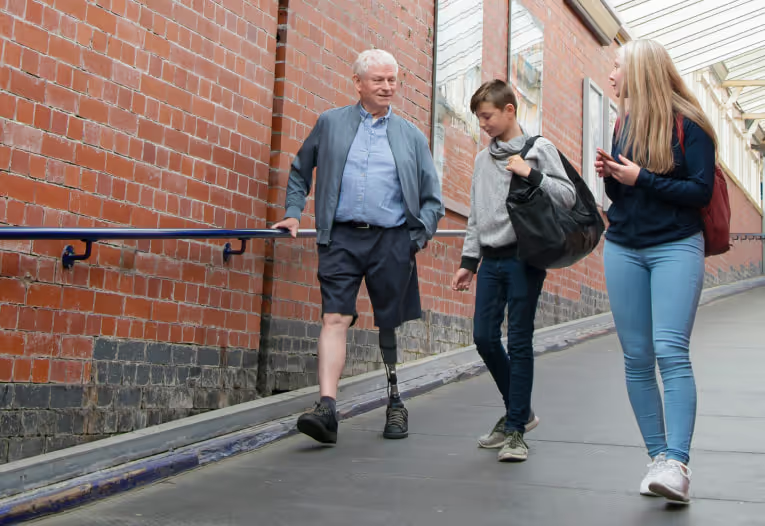Knee Braces for MCL/LCL Tears & Injuries in New Mexico
Discover effective knee braces for MCL and LCL injuries at PrimeCare Orthotics & Prosthetics in Las Cruces. Our expert team provides personalized solutions to support your recovery and improve mobility.

What Are MCL/LCL Knee Braces?
MCL/LCL knee braces are tailored orthopedic supports engineered to strengthen the knee by specifically addressing injuries to the medial collateral ligament (MCL) and lateral collateral ligament (LCL). The MCL, vital for stabilizing the knee joint, stretches from the bottom of the femur to the top of the tibia on the inner side of the knee, and it’s most commonly injured from direct blows during physical activities. Both the MCL and LCL are key in maintaining knee stability, and sudden twists or direct impacts can cause significant damage.

MCL braces are constructed with robust adjustable straps and hinges that offer various levels of support and compression. They constrict the knee’s range of motion, easing stress on the injured ligaments and promoting recovery. MCL/LCL knee braces are often recommended for conservative management of mild to moderate ligament injuries and as a post-surgical safeguard to protect the knee while it heals.
Understanding the Three Grades of MCL Injuries
.avif)
MCL injuries are classified into three grades, indicating the extent of damage and guiding treatment strategies:
Grade I
Grade II
Grade III
Types of LCL /MCL Knee Braces
When treating LCL tears, various types of knee braces offer different levels of stability and support tailored to the severity of the injury:

Most Stable Brace with Adjustable Hinge
- Offers high support extending from thigh to shin;
- Features a lockable hinge to limit full knee straightening;
- Suitable for severe Grade III LCL tears.
Medium Stability with Adjustable Hinge
- Provides moderate support with less coverage on the thigh and shin;
- Adjustable hinge restricts specific ranges of knee movement;
- Recommended for Grade II LCL Sprains.
Medium Stability Without Adjustable Hinge
- Similar support level as medium stability braces;
- Hinges are fixed and do not adjust for movement restrictions;
- Suitable for some Grade II LCL sprains.
Revitalize Your Knee Health with PrimeCare
Contact us now and discover the optimal MCL injury brace for your needs!

Custom Process for Braces Addressing MCL/LCL Tears

- Stage 1: Assessment
We start with a detailed assessment that focuses on understanding your symptoms and challenges caused by your knee injuries.
- Step 2: Consultation and Recommendation
Based on the assessment, we recommend the optimal hinged knee brace for your specific MCL or LCL injury. We discuss the benefits of different brace options and address any questions you have.
- Step 3: Measurement and Customization
Next, we take precise measurements of your knee to ensure a custom fit for your MCL brace. We use advanced technology to create a brace that provides maximum support and stability.
- Step 4: Fabrication
Using high-quality materials, we fabricate your custom MCL brace for the knee with attention to detail. Throughout this process, we keep you informed about the progress and expected timeline.
- Step 5: Fitting and Adjustment
Once completed, we schedule a fitting appointment to deliver your custom brace. During this session, we ensure the brace fits comfortably and functions effectively and make adjustments as needed.
- Step 6: Education and Support
We provide thorough instructions on wearing and caring for your hinged knee brace. We offer ongoing support, including follow-up appointments to monitor your progress and adjust the brace if necessary.
Why Choose PrimeCare Orthotics & Prosthetics for Your MCL/LCL Tear Braces?

Expert Knowledge

Advanced Technology

Customized Solutions
Insurance and Financing
Contact Your Local MCL/LCL Braces Provider in New Mexico
PrimeCare is conveniently located in Las Cruces and proudly serves patients from Ciudad Juarez, El Paso, and neighboring areas. Contact us today to discover how we can help you!
Mon-Fri: 9:00am-5:00pm
Sat-Sun: Closed
FAQs
What can cause MCL/LCL Injuries?
Injuries to the medial collateral ligament and lateral collateral ligament can result from various causes, including:
- Sudden twisting movements during sports or physical activities;
- Direct impact to the knee, such as from a fall or collision;
- Overextension or hyperflexion of the knee joint.
What are the common symptoms of an LCL tear?
Symptoms associated with an LCL injury include:
- Knee instability, especially noticeable when standing or under stress;
- Sensation of the knee locking or catching during movement;
- Numbness or weakness in the foot;
- Pain localized along the outer side of the knee (LCL pain);
- Stiffness in the knee joint;
- Swelling and tenderness specifically along the outer knee area.
When should I wear my MCL brace?
We recommend wearing your knee brace during:
- Standing, walking, or performing exercises as advised by your doctor.
- Your doctor may also suggest wearing it while sleeping during the initial stages of recovery.
- For detailed exercise recommendations for managing MCL tears, refer to our comprehensive exercise guide.
How long should I use an MCL brace?
The duration of wearing an MCL brace varies depending on the severity of the injury:
- Grade I MCL sprains typically don’t require bracing.
- Grade II MCL tears often require wearing a brace for a minimum of 3 weeks.
- As current expert guidelines recommend, grade III tears typically require wearing a brace for at least 6 weeks.

.svg)
.svg)


